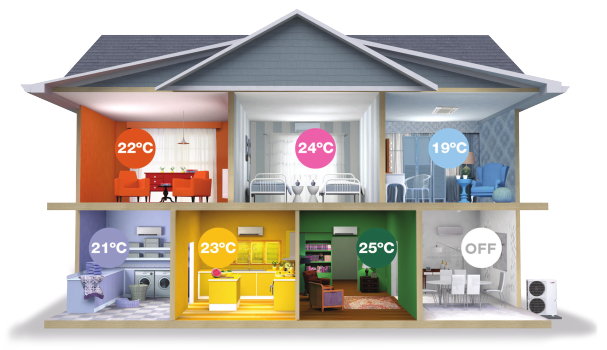
What is a ductless system and how does it work?

A ductless HVAC system, also known as a mini-split system, is a heating and cooling solution that does not require the use of ductwork. These systems are perfect for older homes in Ontario that have radiators. Instead, a ductless HVAC system consists of an outdoor unit that contains a compressor and a condenser, and one or more indoor units that contain an evaporator and a fan.
The outdoor unit pumps refrigerant to the indoor units, where it evaporates and absorbs heat from the air inside the room. This cooled air is then blown into the room by the indoor unit’s fan. In the winter, the process is reversed, with the indoor unit drawing heat from the air outside and using it to warm the air inside the room.
One of the main benefits of a ductless HVAC system is its flexibility. Because each indoor unit is independent, you can control the temperature in each room individually. This means you can set different temperatures in different rooms, or even turn off the system in unused rooms to save energy.
Another benefit is that ductless systems are relatively easy to install. Because they don’t require ductwork, they can be installed quickly and without the need for major renovations. This makes them a good option for older homes that may not have the space or infrastructure for traditional ducted systems.
In addition, ductless systems are generally more efficient than traditional HVAC systems. Because they don’t rely on ducts to distribute air, there is no loss of air due to leaks or other issues. This means that the system can deliver cooled or heated air directly to the room, without losing any of its effectiveness.
Overall, a ductless HVAC system is a convenient and efficient solution for heating and cooling your home. It’s flexible, easy to install, and can help you save energy and money on your monthly energy bills. Contact us for a free quote or just to learn more!
Frequently Asked Questions on Ductless Systems
Expert Answers.
WHAT ARE THE DIFFERENCES BETWEEN A CENTRAL SYSTEM AND A DUCTLESS SYSTEM
The central air system works very similar to a ductless system with one key difference. In a central system, there is only one evaporator whereas a ductless system can have multiple evaporators. Each indoor unit has its own evaporator. This means you can include up to eight indoors units.
Why a mini/single split or a multi split system versus a central ac?
There are several reasons why: If a homeowner purchases an older home which does not have duct work already. They cannot install a central unit without installing duct work in their attic, basement, and other rooms. This is a very expensive option as this type of work requires consulting professional engineers to re-design and approve drawings on top of the cost to supply and install the central AC. A more attractive and cost effective option is to install a ductless solution. This is especially true for Toronto and the GTA where there are many older homes currently being being heated with electricity or boiler systems without ducts.
what about the energy savings?
One of the most attractive reasons for ductless systems is the energy savings. The problem with central AC’s and conditioning through ducts is that there are always leaks which causes conditioned air leaking into non-wanted areas such as attics and crawlspace. Leaks work both ways meaning hot air could leak into a duct delivering cool air thus not delivering cool enough air to your house.
Why are SINGLE AND multi-split systems the ultimate in zoning?
Zoning means different temperatures are maintained in different places dependent on your need. For example, in the summer, if you have zoning air conditioning you can reduce the amount of cool air delivered to your bedroom during the daytime when not needed and deliver more cool air to the kitchen and family room that is currently being occupied. You can then reverse this in the evening when you require cooling in your bedroom. Ductless systems provide the same comfort because each unit in each room has an evaporator and each room temperature can be controlled separately.
Are ductless homes just for older homes? what other applications are there?
Besides older homes without duct-work. Ductless systems are ideal for renovations and remodeling where extensions or additions to your home is added. It can be costly or unwanted to add ducts so ductless is perfect. Ductless systems are also ideal for basements, garages, small businesses, server rooms, and even a “mancave”.
What is a ductless unit with Variable Refrigerant Flow?
Variable Refrigerant Flow means that the system is able to control the amount of refrigerant entering each indoor unit. The most popular technology behind this is called Inverter. This technology allows the system to adjust the capacity according to the changes in the air conditioning load and the differences between the indoor temperature and the set temperature. Without Inverter technology, the capacity is constant and the temperature is controlled by stopping and starting the compressor repeatedly.
